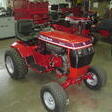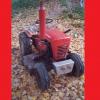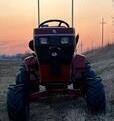Leaderboard
-
in all areas
- All areas
- Markers
- Marker Comments
- Marker Reviews
- Articles
- Article Comments
- Article Reviews
- Classfieds
- Classified Comments
- Classified Reviews
- Wiki's
- Wiki Comments
- Wiki Reviews
- Blog Entries
- Blog Comments
- Images
- Image Comments
- Image Reviews
- Albums
- Album Comments
- Album Reviews
- Files
- File Comments
- File Reviews
- Posts
-
Custom Date
-
All time
November 28 2011 - November 23 2024
-
Year
November 23 2023 - November 23 2024
-
Month
October 23 2024 - November 23 2024
-
Week
November 16 2024 - November 23 2024
-
Today
November 23 2024
-
Custom Date
03/14/2024 - 03/14/2024
-
All time
Popular Content
Showing content with the highest reputation on 03/14/2024 in all areas
-
17 points
-
14 pointsBates Steel Mule Many early tractors were a bit strange looking by today’s standards and the Bates Steel Mule was no exception. The Steel Mule Tractor was designed at the dawn of the industrial age and tractors were designed to pull any horse-drawn implement the farmer owned. In 1913 the Joliet Oil Tractor Company began production of their first tractor, The Steel Mule. The tractor was powered by a four-cylinder 13-30 gasoline engine coupled to a transmission with two forward speeds and one reverse. Sounds rather conventional so far, but rather than driving large steel wheels the Steel Mule had a single centered crawler track at the rear to move the tractor and two front wheels for steering and stability. One very unconventional but useful feature was the front wheels that could be adjusted up or down to keep the tractor level while working on a hillside. The driver could sit on the installed seat or utilize the telescopic steering shaft to operate the “Mule” from the seat of the implement being towed. Steel Mules were exported to England and Ireland by 1916 priced at £500, ($ 36,740 in US dollars today) and were shown at the Highland & Agricultural Society of Scotland's tractor trials in October 1917 A half-century later a somewhat similar propulsion design was used on the 1953 Endless Tread Garden Tractor. In 1919 the Bates Machine & Tractor Company introduced a more conventional half-track design known as the Model D with two rear tracks, it sold for $ 1,500. Three different engine manufacturers were used, Midwest Engine from 1921 to 1925; Beaver Engine from 1926 to 1928; and LeRoi engine was used from 1929 to 1937. Bates also produced a kit to convert a Fordson tractor to a half-track tractor to increase traction and reduce soil compaction.
-
12 pointsSpent yesterday afternoon and evening laying some red paint, always an exciting day! This is the 702 project I've been helping a friend with. There's been a lot of sheetmetal work In this, but seeing the outcome makes it all worth it
-
10 pointsFellow members, I caution you on equating “Chinese” with poor quality. This can lead to misjudging, and underestimating, both products and a people. Engineers and manufacturers in that country have designed and built spacecraft, nuclear weapons, supercomputers, telephony equipment, and some of the best drones in the world. There are superb software engineers working in China. Further, those same engineers and manufacturers have figured out how to lower the specs and tweak the manufacturing processes on many things to where they can be made at lower cost and sold to buyers all over the world eager to get them. These products often serve adequately for their function. It is WE, the consumers, that have been driving this by seeking to constantly have more for less. We have been getting (and will continue to get) what we are willing to pay for.
-
6 pointsBut that's not the secret I want to share. I placed a sandwich bag over the JB Weld to get the shape of the original fan shroud. It's suprisingly easy to do it by feel . Your finger can discern what is a low spot and fill it in.JB really makes good body filler for tiny spits like this and also repairs the split metal. Sorry I don't have the original hole but it took quite a few shrink sessions with a body hammer to close it up. Of course the secret sauce is the sandwich bag which allows you to finger tool the JB and keep it from sagging out if place.
-
5 pointsThis afternoon I got the new Carlisle's mounted on the 854, I'm really happy with this tire choice, now to give the fronts a sandblast and paint.
-
5 pointsWhen it's all finished, apply one of those bullet hole decals over it.
-
5 pointsYou'll want to take a very close careful look at your own carb body to verify that the BOTTOM of the shaft is tight before attempting repair. I'm finding that the Magnum engines have a Walbro carb that's prone to wearing the body at the top AND bottom. The bottom bore isn't repairable without specialized machinery. When you remove the throttle shaft blade screws be VERY careful. You'll most likely need to grind a small amount off the back of the screw where it sticks past the shaft. Many of these screws are staked in. Many are in using loctite. Almost all break if you don't grind the back. Certainly try the tighten/ loosen/ tighten/ loosen/ tighten/ loosen/ method too. The part numbers are: Carb copper washers: Mcmaster Carr # 5906K561 Or Hillman 58087 They aren't on isave because he wants to sell you a new aftermarket cheap carb rather than repair your own original. I can no longer advise his carbs after having a couple wear out prematurely.
-
4 pointsThe Chinese can build world class products. They just don't ship them here. It would be a mistake to judge their capability based on the junk you see at stores for cheap.
-
4 pointsOil attracts dirt and dust. Gets on your hands and clothes. Wipe or brush this on instead. Available at home Depot and Lowes
-
4 pointsAn 18 Vanguard in a C-120, and a 16 Vanguard in a 312-8. The back side of the PTO hole is the center line of the crank shaft. I raised the engine mount plate 3/4".
-
4 pointsI graduated high school from Lathrop, a small town in northwest Missouri about 40 miles north of Kansas CIty. "In the early 1900's Lathrop was know as the mule capital of the world and became the largest mule dealership in the world. During the Boer War in 1901-02, approximately 170,000 mules where handled by Guyton and Harrington. Almost all of these mules where shipped from the Lathrop location over seas to their final destination in South Africa. By 1918, they had 18 buildings on 4,700 acres of land with 150 men maintaining up to 50,000 mules." (Inside the quotes are various parts of articles found on the internet that I copied from.) I gave the history because part of the Guyton Harrington farm structures were still present in the 1970's and 80's and I was hired to do repairs to some of them. One of them was a huge round cement water tank that was filled using a windmill. One of my jobs was to make and install a wooden oak "connecting rod" when it broke between the windmill on top and the pump on ground. That was a pretty easy job. One time the owners ask me to make a lid for the water tank. In places, the cement was flaking off the sides of the tank exposing the rebar inside. The original lid which was probably 30" square was missing. Up the side of the water tank was a wooden ladder. I made a cover, then me and my helper proceeded to climb the ladder hefting the lid. I suppose the tank was 25 to 30 (probably more) feet high. We were absolutely wore out getting the lid up there and had to stop more than once to rest. We rested a corner of the lid on a 1x4 rung with me above and my helper below. Once on the top all we laid the lid over the access hole. The owners asked me to inspect the cement top of this tank that is (very conservatively estimated sitting here in my recliner) to be 25 feet across . The cement lid had several holes in it where the rebar had rusted and the old cement deteriorated and fell inside--to the point that there was NO WAY I was going to get on top of that thing! That was one of the scarier projects I did. That tank supplied the water to the Guyton Harrington farm and I was told water lines were laid to watering troughs scattered around the farm. The last time I passed the farm, someone with equipment that I could only dream of having access to had built a roof over the water tank.
-
3 points
-
3 points
-
3 points
-
3 pointsI did one for my son a few years ago Excellent choice. Had one on an FEL also Homemade muffler on this one.
-
3 points
-
3 pointsThis.... is a rear tire/wheel combo. This.... is also a rear tire/wheel combo. These....are front tire/wheel combos. All four are now filled with Rimguard. There were some trials and tribulations involved with the pumperizing system. All good. The to-do list is gettin' shorter!!
-
2 points
-
2 points
-
2 points
-
2 pointsWe used a small non submersible pump I purchased at Harbor Freight for about $65. Because of the tiny orifice that the fluid has to pass through going into the tube, this pump was no faster than using a drill mounted pump. We will use it for other things around the yard from time to time so I don't feel like it was a waste of money but it certainly did not speed the process up any like I was hoping. I would LIKE to attain as close to 100% fill with these tires as I can. I think we are probably no more than 70%, 80%. I've read that having a tire at 100% with a heavier tractor could be dangerous in that, if you go over rough ground the fluid needs to push out somewhere as it's being pushed up on the bottom. I don't see that being a serious issue for us in particular.
-
2 pointsI've certainly been on both sides of that coin. Definitely a Life Lesson worth remembering.
-
2 pointsI will have some rim guard left from the retiring of my Farmall M. How are you filling your small tires. Some say for tubeless break the bead on one side and pour in the recommended amnount ...not sure how easy it would be to reseat the bead. How are you pumping it into tubed tires?? Also I think you have indicated you completely fill the tire. Rim guard indicates about 80% fill keeps eh valve stem above the fill line at 12 o'clock.
-
2 pointsI did one a few years ago in a 416-8. I used an engine plate from a gt1100 which adapted the engine bolt pattern and gave the correct crankshaft height. Used a engine pulley from a c-85 which had a 1" crank, an easy swap that you'll be very pleased with!
-
2 points
-
2 pointsLast year I replaced both #21 and #32 as part of my work to add dual front remotes to a 520 chassis. #21 (which runs from the pump to the control valve) is the only line that will see any significant pressure; #32 runs to the filter and transaxle “tank”. @JoeM is on the money with doing replacements. Metal is better and there isn’t a lot of room anywhere! I used the new alloy brake line which is very easy to form, uses a regular tubing flare tool and won’t rust. Per its specs, working max pressure is 900psi, well under the 700. JIC connectors worked fine. I was a bit leery of tightening the connections, so I ran it and tightened until it stopped leaking and then gave it another 1/8th of a turn. Some advice I followed from an “old hand” at hydraulics was to make sure there are no rubbing edges against the tubing and to support it every 10-12 inches to prevent vibration that can weaken/break a connection. You have flaring experience so a quick practice will get you dialed in on how much you need to extend beyond the tool to get the right length of flare. Good luck!
-
2 pointsThe simplest thing you can do is to take the cover off of the points and clean the contacts. Letting an engine sit can cause the points to oxidize. Until cleaned, it won't start.
-
2 points
-
2 pointsWorked on several Wheel Horses today. I took my snowplow off the 854. Touched up some bare spots on the plow frame with new paint. Took off my steering wheel on the 854 ( easy I have a pin in it) and painted a bare spot on the gas tank top. Took the snowplow off the RJ and stored. Put some Fix a Flat in my 314 toro front tire. Seal around the rim leaking air. Cleaned out my spreader and did two applications today. Grubbed for the lawn and Scott’s Weed and Feed. Pretty quick work with the spreader I have. Checked out the HY belt guard that Mark Godzig made me (traded a three race pulley). I have one but also have another hydraulic system to install on a round hood tractor that it will be used for. Also primed and painted the belt guard. Fits great and Mark did a great job making this from measurements I sent him. Also primed a heavy duty RJ snowplow frame I got from Rodney Burger in Florida last month. Whoever made this didn’t want it bending!
-
2 pointsGood meal to finish to the day. A nice ribeye grilled to a perfect medium moo, smothered in sauteed mushrooms, with a side of steak fries & south west corn. Tomorrow it's back to cheap hot dogs, Kraft mac & cheese, or Ramen noodles.
-
2 pointsI spent the day sandblasting and painting wheels for the new 854 I picked up a few weeks back. Couldn't take the 23x8 50x12 tires that came on it so I bought a new set of Carlisle Tru power 6-12 tires for it. Hopefully it looks good with new shoes
-
2 pointsA week of 50F temps and an inch of rain yesterday = a roll down the frost lumps day. Put the "new" $175 310-8 to work for the first time. He did good, but could use a couple new sneakers and some weight on his rear. I'm a hydro guy, but the gear drive was OK for this job. It ran for 2 hours non-stop in H2nd. I only had to push the clutch one time to back it in the shed.
-
1 pointThe bottom part of the shaft is good and tight. Thank you for the info, appreciate you @ebinmaine
-
1 pointIt's right at the corner of the round fan shroud joining the riser
-
1 pointA salute to the Silo Dairy farmers work with nutritionists who create healthy, balanced diets that are specific to the cows’ needs – based on their age, whether they’re milking, whether they’ll soon have a calf, and many other factors. Some dairy cows eat as much as 100 pounds of food per day. The ingredients often include human food byproducts, grain, a mixture of grass hay, alfalfa hay, as well as corn and grass silage that is grown on the farm, harvested green and stored in an anaerobic chamber. Fifty percent or more of a dairy cow’s food intake is silage. Woolford (1984) defined silage as “the product formed when grass or other material of sufficiently high moisture content, liable to spoilage by aerobic microorganisms, is stored anaerobically”. Silage is produced by ensilage, that is, the placing of crop material inside a vessel or a structure called a silo. Excavations at the Egyptian town of Guft show trench silos used around 1500 BC. A silo is a structure for storing bulk materials. Silos are used in agriculture to store fermented feed known as silage. Three types of silos are in widespread use today: tower silos, bunker silos, and bag silos. Tower silos are the tall cylindrical items we are accustom to seeing attached to dairy barns thought the countryside. They contain corn and/or grass silage which will make up the majority of a cow’s dilate and are usually unloaded from the top of the pile, originally by hand using a silage fork—which has many more tines than the common pitchfork; 12 vs 4—and in modern times using mechanical unloaders. An advantage of tower silos is that the silage tends to pack well due to its own weight, except in the top few feet. I can recall many winter days when a pickax was needed to break up the frozen silage in the winter and the fermented silage by springtime was probably ready to be distilled, cows seemed to love it. The bunker silo is an improvement on the Egyptian trench silos use in 1500 BC. Bunker silos are trenches, usually with concrete walls, that are filled and packed using tractors and loaders. The filled trench is covered with a plastic tarp to make it airtight. These silos are usually unloaded with a tractor and loader. They are inexpensive and especially well-suited to very large operations. Bag silos are heavy plastic tubes, usually around 8 to 12 ft in diameter, and of variable length as required for material to be stored. They are packed using a machine made for the purpose, and sealed on both ends. They are unloaded using a tractor and loader or skid-steer loader. The bag is discarded in sections as it is torn off. Bag silos require little capital investment and considerably less labor the conventional tower silo. The silage is harvested using a Round Baler and the bales are placed end to end where a device holds each bale off the ground as the bag is slipped over it. The farm I grew up on is now using the bag silo system.
-
1 pointHere are a couple of pictures of my 312H hydraulic rubber lines showing the fittings and routing. Top picture is as found and I assume factory routing. Bottom is during the rebuild of that machine. Hoses were all re-used with just new 'O' rings installed on the hose ends. My 520's are a mix of rubber and hard lines from the factory depending on year. Both work fine.
-
1 pointJust make sure the cupholders are already occupied by a couple of cold recreational beverages!
-
1 pointAlso if you are getting spark and fuel, make sure there is no water in the gas.
-
1 point
-
1 pointI clicked on the laughing emoji but obviously I'm not laughing at the part about people dying in silos - that's not funny at all. I have heard the joke about taking a dump (or peeing) in a round barn before. I think it was from my Dad, could have been my grandpa but he was a bit too proper to tell a joke like that, I think. I'm a big fan of silos and have a collection of pictures I've taken over the years... If I see an old one I try to get a picture of it, even if it's during a drive-by. Here's one:
-
1 point
-
1 pointBefore worrying about a "blown engine" do a step by step check of spark and fuel. I would start with making sure you have a good spark at the spark plug. You can lay the plug on the head and turn the engine over to see if there is spark. If not replace the plug and if still no spark check the points. May need to replace points and condenser. Once you determine you have spark start working through the fuel supply. Is the gas cap venting air ok? you can pull the gas line off the carb coming from the fuel pump. Is it pumping fuel from the pump when you turn the engine over? If not you may have a plugged gas cap, plugged fuel filter or a bad fuel pump (would need a rebuild or replace). If you have spark and fuel to the carb then I would assume its something plugging the carb and would need a good cleaning. That is just my but I am sure others here will chime in on suggestions. Best of luck!
-
1 point1.5 qts. 80w90 gear oil or a weight thereabouts. 3 and 4 speeds all use 1.5 qts while 6 and 8 speeds call for 2 qts.
-
1 pointYou definitely get what you pay for. Did you by chance check how much grease was in the bearings to begin with?
-
1 pointI finished putting the rear end back together on the 518-h. Took it for the first drive and it runs and drives amazing! Next up is a beefy rear hitch.
-
1 pointTHANKS EVERYONE!!! So far it's been a good day. Took a break from testing generators today & had some good garage time this morning. Just took a break to have some stuffed poblanos for lunch. Then I'm gonna see what trouble I can get into today.
-
1 point
-
1 point1739 was replaced by 101147 and it is no longer available from Toro. This link should take you to parts lists that show the muffler. Looks like a common model still available from aftermarket suppliers. One needs to know the pipe thread size to get the correct one. https://www.partstree.com/parts/toro-101147
-
1 pointI'm using one on my 314-8 (K321). I had a run of the mill old piece of black steel pipe in the corner of the shop that threaded into the engine. I believe it was 1" NPT. I cut it to length, slipped the muffler over, and clamped'r down. I do recall that it seemed a little loose at first test fit, but clamped down just fine with no leaks. Its quieter than the stock muffler I had. I ended up going that way because I was having belt clearance issues between the stock muffler and my wood chipper that runs off the PTO.

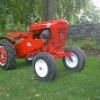
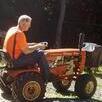
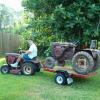


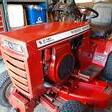
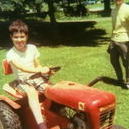

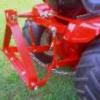

.thumb.jpg.e027905726836f41d35a27e60c2cb4f9.jpg)
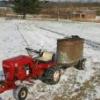
.thumb.jpeg.8bdd6995142db7fbcf4df2d7b452df33.jpeg)

